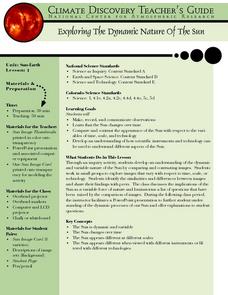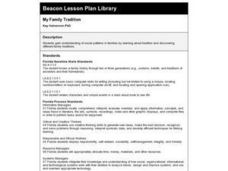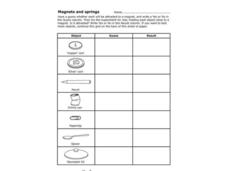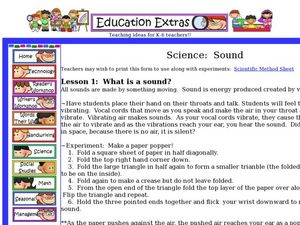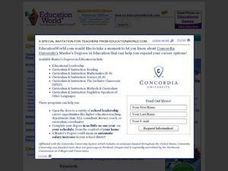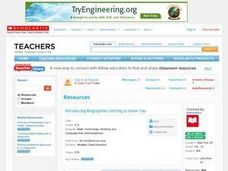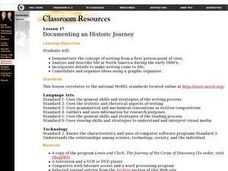Curated OER
Plant Cycles
Students identify plants parts and their functions. In this plant cycle lesson, students examine parts of plants and how the parts help them survive in its environment. Students use graphic organizers, the internet, books and...
Curated OER
Exploring the Dynamic Nature of the Sun
Students compare and contrast images of the sun taken at different times and viewed at different scales. They record their observations in a journal and create a graphic organizer to help analyze their observations.
Curated OER
My Family Tradition
Students examine different family traditions to further explain social patterns. They complete a graphic organizer using educational software.
Curated OER
Dew Point Temp Worksheet
In this temperature learning exercise, students complete 3 graphic organizer by determining the dew point temperature based on the dry-bulb and wet-bulb thermometer readings.
Curated OER
Exploring Magnetism in Solar Flares
Students apply concepts of magnetism to help them understand the production of solar flares. In this solar flare lesson, students complete activities and graphic organizers to help them learn about magnetic fields on the surface of the...
Curated OER
Formulas and Mole Conversions
For this formulas and mole conversion worksheet, students answer 22 graphic organizer, multiple choice, and short answer questions pertaining to formulas and mole conversion.
Curated OER
Temperature in The Atmosphere
In this science worksheet, middle schoolers find the answers to the five questions and they fill in the graphic organizer for the temperatures found in different heights of the atmosphere.
Curated OER
Characteristics of Materials
In this science graphic organizer worksheet, students find 6 objects around their home and describe the materials they are made of. They tell what the object is made of, what it is used for, and if the material is a good choice, and why...
Curated OER
Light Is Amazing
Pupils investigate light and its energy. They discuss the properties of light, research how much light the moon absorbed on their birthday on a website, complete a graphic organizer, and create a kaleidoscope.
Curated OER
Finding Epicenters
For this earthquake worksheet, students determine the distance of different cities to the epicenter of an earthquake based on the "P" and "S" wave arrivals on the seismographs. This worksheet has 1 graphic organizer and 2 short answer...
Curated OER
Friction
In this friction worksheet, students examine objects around them by writing details in the graphic organizer. Headings include high friction, low friction, useful, and not useful. Pictures are provided to prompt students.
Curated OER
Magnets and Springs
In this magnetism worksheet, students complete a graphic organizer by predicting which of the 7 pictured objects will be attracted to a magnet and which ones will not. They write their own experiment about whether an object will or will...
Curated OER
Compare and Contrast Type 1 and Type 2 Diabetes
Young scholars use graphic organizers to compare and contrast Type 1 and Type 2 diabetes. In this diabetes instructional activity, students are given information on the two major types of diabetes. They analyze how to compare and...
Curated OER
What is a Sound?
Second graders explore the concept of sound. In this sound lesson plan, 2nd graders discover what sound, vibrations, and pitch are through several experiments. Students watch a Power Point presentation that allows them to complete a...
American Chemical Society
Change in Temperature - Endothermic Reaction
Now that learners have been exposed to chemical changes, they learn that some take in heat and therefore, decrease in temperature. The same reaction that they have been investigating between baking soda and vinegar is revisited,...
Curated OER
How Do Living Things Form Communities?
In this communities worksheet, students will write down 1 main idea about communities formed by living things. Then students will brainstorm 3 details to support their main idea. This worksheet is a graphic organizer.
Curated OER
Let Me Tell You About My Favorite Animal
Students create books about their favorite animals using graphic organizers.
Curated OER
Communication Comparisons
Learners investigate various methods of communication. In small groups, they conduct Internet research, compare/contrast three methods of communication, and complete a graphic organizer.
Curated OER
Introducing Biographies-Getting to Know You
Young scholars study biographies as a nonfiction genre while examining a variety of examples. Next, they access and complete an online tutorial about biographies. They choose one person that interests them to conduct further research...
Curated OER
The Editorial Revisited
Learners identify different types of editorials. They explain, using a graphic organizer, the elements that make an editorial powerful. They offer elements they came up with and the examples and list them on the board.
Curated OER
Explore the Animal World
Third graders use a variety of resources to do research on an animal. Their final project is a graphic organizer for display and an informative multimedia slide show.
Curated OER
Unit Plan Template
Learners research the adaptations of desert animals and build their research skills. In this the adaptations of desert animals activity, students describe major factors that desert animals have on their habitat. Learners...
Curated OER
Oh, Go Fly a Kite!
Students research and report on aspects of kites including: history, types, building and flying kites. They use Inspiration Software as a graphic organizer. They use gathered research to complete informational booklets.
Curated OER
Documenting an Historic Journey
Students read and analyze journals written by Lewis and Clark. They watch and discuss a video segment, complete a graphic organizer, and write a journal entry written from the point of view of someone involved with the Lewis and Clark...

